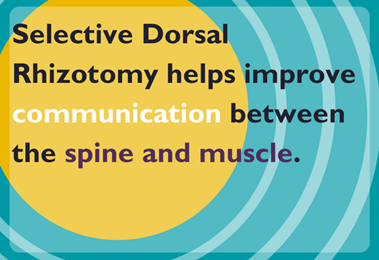Patient Story
Spastic Quadriplegic Cerebral Palsy: Emmy's Story

“Hello, sweet girl!”
Therapist Angela Stone, O.T., gathers 3-year-old Emmy into her arms on the colorful padded floor of the Johns Hopkins All Children’s Center for Child Development and Rehabilitation, soothing her with happy chat as she gets to work.
“Here we go … let’s do this.”
The therapist takes Emmy’s left arm and moves it up and down, forward and back. She repeats with the right arm. But Emmy is restless today. She’s not completely buying in.
Time to change the approach. As Stone works with the toddler, she begins to sing.
“Twinkle, twinkle, little star … how I wonder what you are …”
Emmy raises her head and begins to listen — as if with her whole body. She giggles and softens, allowing the therapist to do what she does best.
Stretching and strengthening Emmy’s limbs in order to give her greater range and function is the goal. For a little girl diagnosed with spastic quadriplegic cerebral palsy, it is a Herculean task.
“Her brain has a hard time telling her body what to do,” Stone says. “She doesn’t move the way a typical child moves. So she gets frustrated. It also affects her speech, so she isn’t able to easily communicate, and that frustrates her even more.”
Everybody around the rehab center knows Emmy. She has been coming for therapy since she was a baby.
Born early, weighing just 800 grams (just under 1.8 pounds), Emmy spent her first 147 days in the neonatal intensive care unit (NICU).
“It was a roller coaster,” says her mom, Megan. “One that no parent wants to be on.”
Emmy has weathered feeding problems, sleep apnea, seizures and reflux, to name just a few of her challenges. But her biggest one is neurological.
“We want Emmy to be as independent as she can be, physically and mentally,” says James Chinarian, M.D., a pediatric rehabilitation specialist.
But what could the team do to help set Emmy up for the future? How could they help her unlock the constraints of her body and give her the most freedom — not just to become a fulfilled adult, but more immediately, just to have fun exploring her world — to do what kids do?
Much of the answer lies in comprehensive therapy — lots of it.
Emmy’s schedule is packed these days. Each week, she has two days of physical therapy, two days of occupational therapy, and one to two days of speech, not including other clinic visits.
Why so much therapy — so early in life?
“It’s simply the most important time to do it,” Chinarian says. “These are the formative years, when children are progressing in their motor skills and forming language. Early intervention is really important.”
The hope is that consistent, comprehensive therapy will assist Emmy in carving out new neural pathways to master functions that the damaged portions of her brain are not able to facilitate.
Having the right gear doesn’t hurt either.
When Emmy was not quite 2 years old, the rehab team outfitted her with a power wheelchair and began to teach her how to make it move. Small motion sensor switches were placed under a tray on her chair, and when Emmy would put her hand over the sensor, it would move forward, then left, right and reverse.
“I’d be lying if I said I didn’t think the idea was a little insane for my baby at first. But she loved it … even bumping into walls,” Megan says with a laugh. “Now she likes to do doughnuts.”
Because her verbal abilities are limited, Emmy is also learning to work with an eye gaze device to communicate. If she sustains her gaze on a picture or symbol on the screen, the device will track her gaze and share her need or desire audibly.
“She will tell us she wants to listen to music, and she’ll pick a song,” Megan says. “She loves to trigger the device to say, ‘Hi. My name is Emmy.’”
Self-determination is a big idea for such a little girl.
But that’s what the Johns Hopkins All Children’s rehabilitation team wants for kids like Emmy. To give them every tool possible to have a say in their own lives and care, and the freedom to move forward on their own path.
“I love that Dr. Chinarian has never put limitations on Emmy,” Megan says.
“And our therapists … they’ve been so supportive. We feel their love for Emmy, and they mean the world to us.”
Chinarian says he understands that not every parent is able to commit to the level and frequency of therapy considered to be optimal. Still, he says, he sees so many amazing families.
“Hopefully, you always start with a parent who loves their child sitting in front of you,” Chinarian says. “That is a very strong place to start. Then we can do our best to make good things happen.”
Not long ago, Megan sent Emmy’s therapists a video she had taken on her cell. It was a bright, sunny day. Emmy’s 8-year-old sister, Aubree, was riding her scooter — with Emmy, in her power wheelchair, following close behind.
Just two sisters, out playing in the sunshine. Doing what kids do.






